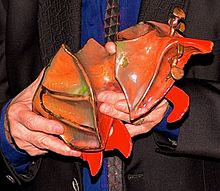The Guldbagge for Best Film is a Swedish film award presented annually by the Swedish Film Institute (SFI) as part of the Guldbagge Awards to the best Swedish motion picture of the year.

The 48th Guldbagge Awards ceremony, presented by the Swedish Film Institute, honored the best Swedish films of 2012 and took place January 21, 2013, at Cirkus in Stockholm. During the ceremony, the jury presented Guldbagge Awards in 19 categories. The ceremony was televised in the Sweden by SVT, with actress and comedian Babben Larsson hosting the show.
The 47th Guldbagge Awards ceremony, presented by the Swedish Film Institute, honored the best Swedish films of 2011 and took place January 23, 2012, at Cirkus in Stockholm. During the ceremony, the jury presented Guldbagge Awards in 19 categories. The ceremony was televised in the Sweden by SVT, with actress and comedian Petra Mede hosting the show for the second time in a row.
The 49th Guldbagge Awards ceremony, presented by the Swedish Film Institute, honored the best Swedish films of 2013 and took place January 20, 2014, at Cirkus in Stockholm. During the ceremony, the jury presented Guldbagge Awards in 19 categories. The ceremony was televised in the Sweden by SVT, with actress and comedian Sissela Kyle hosting the show for the third time. The ceremony also celebrated the prize's 50th anniversary.
The Guldbagge for Best Director is a Swedish film award presented annually by the Swedish Film Institute (SFI) as part of the Guldbagge Awards to directors working in the Swedish motion picture industry.
The 2nd Guldbagge Awards ceremony, presented by the Swedish Film Institute, honored the best Swedish films of 1964 and 1965, and took place on 15 October 1965. Swedish Wedding Night directed by Åke Falck was presented with the award for Best Film.
The Guldbagge for Best Actor in a Leading Role is a Swedish film award presented annually by the Swedish Film Institute (SFI) as part of the Guldbagge Awards to actors working in the Swedish motion picture industry.
The 3rd Guldbagge Awards ceremony, presented by the Swedish Film Institute, honored the best Swedish 1965 and 1966, and took place on 17 October 1966. Heja Roland! directed by Bo Widerberg was presented with the award for Best Film.
The Guldbagge for Best Actor in a Supporting Role is a Swedish film award presented annually by the Swedish Film Institute (SFI) as part of the Guldbagge Awards to actors working in the Swedish motion picture industry.
The 4th Guldbagge Awards ceremony, presented by the Swedish Film Institute, honored the best Swedish 1966 and 1967, and took place on 9 October 1967. Persona, directed by Ingmar Bergman, was presented with the award for Best Film.
The 7th Guldbagge Awards ceremony, presented by the Swedish Film Institute, honored the best Swedish films of 1969 and 1970, and took place on 26 October 1970. A Swedish Love Story and Mistreatment were presented with the award for Best Film.
The 10th Guldbagge Awards ceremony, presented by the Swedish Film Institute, honored the best Swedish films of 1973 and 1974, and took place on 16 September 1974. A Handful of Love directed by Vilgot Sjöman was presented with the award for Best Film.
The Guldbagge for Best Actress in a Leading Role is a Swedish film award presented annually by the Swedish Film Institute (SFI) as part of the Guldbagge Awards to actresses working in the Swedish motion picture industry.
The Guldbagge for Best Actress in a Supporting Role is a Swedish film award presented annually by the Swedish Film Institute (SFI) as part of the Guldbagge Awards to actresses working in the Swedish motion picture industry.
The Guldbagge for Best Foreign Film is a Swedish film award presented annually by the Swedish Film Institute (SFI) as part of the Guldbagge Awards to the best Swedish motion picture of the year.
The 52nd Guldbagge Awards ceremony, presented by the Swedish Film Institute, honoring the best Swedish films of 2016 and took place on January 23, 2017 at Cirkus in Stockholm. The ceremony was televised by SVT, and comedian Petra Mede hosted the ceremony for the fifth time. She previously hosted the 46th, 47th, 50th, and 51st ceremonies. The nominees were presented on January 4, 2017.
The 46th Guldbagge Awards ceremony, presented by the Swedish Film Institute, honored the best Swedish films of 2010 and took place January 24, 2011, at Cirkus in Stockholm. The jury presented Guldbagge Awards in 15 categories. It was televised in the Sweden by SVT, with actress and comedian Petra Mede as host.
The Guldbagge for Best Documentary Feature is a Swedish film award presented annually by the Swedish Film Institute (SFI) as part of the Guldbagge Awards to award documentary films in the Swedish motion picture industry.
The 53rd Guldbagge Awards ceremony, presented by the Swedish Film Institute, honoring the best Swedish films of 2017 and took place on January 22, 2018 at Cirkus in Stockholm. The ceremony was televised by SVT, and comedian Petra Mede hosted the ceremony for the sixth time. She previously hosted the 46th, 47th, 50th, 51st, and 52nd ceremonies. The nominees were presented on January 4, 2018.
The 54th Guldbagge Awards ceremony, presented by the Swedish Film Institute, honoring the best Swedish films of 2018 and took place on 28 January 2019 at Cirkus in Stockholm. The ceremony was televised by SVT, and comedian Emma Molin hosted the ceremony for the first time. The nominees were presented on 3 January 2019.




